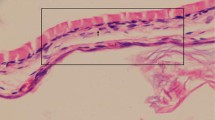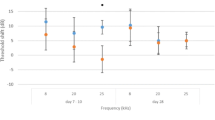Abstract
An antibacterial drug, ciprofloxacin, has been reported to modulate the inflammatory and immune responses on monocytes. Our objective is to evaluate the effectiveness of ciprofloxacin in the prevention of myringosclerosis that is created by myringotomy in rats and to compare it with prednisolone. In this study, 24 healthy Sprague-Dawley type rats of age 3–4 months and 250–300 g weight were used. Rats have been divided into three random groups. Topical ciprofloxacin was administered to the rats in the first group and topical prednisolone was administered to the rats in the third group; no medication was applied to their opposite ears and they were determined as control group. Prednisolone was administered to one ear of the rats and ciprofloxacin was administered to their opposite sides in the second group. After bilateral myringotomies the treatments were applied for 20 days as five drops two times a day. Otomicroscopic examination was made on the 10th day and reperforations were made when necessary. Rats were killed on the 21st day and temporal bone dissections were done. When we evaluate in terms of myringosclerosis and tympanic membrane thickness, in the first group, myringosclerosis and thickness have been observed in two of seven ears (28.6%) where ciprofloxacin was administered and in five of the seven ears (71.4%) where no treatment was applied. In the second group where prednisolone and ciprofloxacin were compared, myringosclerosis and thickness have been observed in six of the ten ears (60.0%) where prednisolone was administered and in four of the ten ears (40.0%) where ciprofloxacin was administered. In the third group, myringosclerosis and thickness have been observed in three of seven ears (42.9%) where prednisolone was administered and in four of the seven ears (57.1%) where no treatment was applied. All histopathological evaluations were made by one pathologist in a blinded manner. In our study, the effect of the ciprofloxacin and prednisolone was similar in preventing the experimental myringosclerosis and TM thickness in rats. When compared with the control groups, this preventive effect was more obvious in the ciprofloxacin treatment group than that of prednisolone.



Similar content being viewed by others
References
Forseni M, Hansson GK, Bagger-Sjöback D, Hultcrantz M (1999) An immunhistochemical study of inducible nitric oxide synthase in the rat middle ear, with reference to tympanosclerosis. Acta Otolaryngol 119:577–582
Asiri S, Hahsam A, Anazy FA, Zakzouk S, Banjar A (1999) Tympanosclerosis: review of literature and incidence among patients with middle-ear infection. J Laryngol Otol 113:1076–1080
Sorensen H, True O (1972) Histology Of Tympanosclerosis. Acta Otolaryngol 73:18–26
Selcuk A, Akdogan O, Ozcan I, Giray SG, Dere H, Ozogul C (2008) Topical Application of calcium channels blockers to reduce the progression of experimentally induced myringosclerosis and tympanosclerosis. Laryngoscope 118:697–705
Wielinga EWJ, Kerr AG (1993) Tympanosclerosis. Clin Otolaryngol 18:341–349
Ozcan C, Gorur K, Cinel L, Talas DU, Unal M, Cinel I (2002) The inhibitory effect of topical Nacetylcysteine application on myringosclerosis in perforated rat tympanic membrane. Int J Ped Otorhinolaryngol 63:179–184
Spratley JE, Hellstrom SO, Mattsson C, Pais-Clemente M (2001) Topical ascorbic acid reduces myringosclerosis in perforated tympanic membranes. A study in rat. Ann Otol Rhinol Laryngol 110:585–591
Khan AA, Slifer TR, Araujo FG, Suzuki Y (2000) Remington JS: protection against lipopolysaccharide- induced death by fluoroquinolones. Antimicrob Agents Chemother 44:3169–3173
Mattsson C, Stierna P, Hellström S (2000) Treatment with dexamethasone arrests the development of myringosclerosis after myringotomy. Am J Otol 21:804–808
Mattsson C, Marklund SL, Hellström S (1997) Application of oxygen free radical scavengers to diminish the occurrence of myringosclerosis. Ann Otol Rhinnol Laryngol 106:513–518
Celik H, Felek SA, Islam A, Safak MA, Arslan N, Gocmen H (2008) Analysis of long-term hearing after tympanosclerosis with total/partial stapedectomy and prosthesis used. Acta Otolaryngol 128:1308–1313
Emir H, Kaptan ZK, Samim E, Sungu N, Ceylan K, Ustun H (2009) The preventive effect of ginkgo biloba extract in myringosclerosis: study in rats. Otolaryngol Head Neck Surg 140(2):171–176
Somers T, Houben V, Goovaerts G, Govaerts PJ, Offeciers FE (1997) Histology of the perforated tympanic membrane and its muco-epithelial junction. Clin Otoaryngol Allied Sci 22:162–166
Santos PF, Leal MC, Peixoto C, Neto SC, Rosas ST (2005) Otomicroscopic and histologic findings of induced myringosclerosis in rats: a critical study of an experimental model. Braz J Otorhinolaryngol 71(5):668–674
Mattsson C, Magnuson K, Hellström S (1995) Myringosclerosis caused by increased oxygen concentration in traumatized tympanic membranes: experimental study. Ann Otol Rhinol Laryngol 104:625–632
Polat S, Öztürk O, Üneri C, Yüksel M, Haklar G, Bozkurt S, Küllü S (2004) Determination of reactive oxygen species in myringotomized tympanic membranes and the effect of vitamin E treatment. Laryngoscope 114:720–725
Görür K (2002) The anti-oxidant and anti-apoptotic activities of selenium in the prevention of myringosclerosis in rats. J Laryngol Otol 116(6):426–429
Ozcan I, Selcuk A, Ozcan KM, Akdogan O, Giray SG, Dere H, Ozogul C (2008) The effect of topical doxycycline in the prevention of experimental tympanosclerosis. Laryngoscope 118(6):1051–1056
Cankaya H (2008) Effects of topical mitomycin and trimetazidine on myringosclerosis. J Otolaryngol Head Neck Surg 37(6):882–887
Cutler JL, Wall M, Labadie RF (2006) Effects of steroid and NSAID in clearing middle ear effusion in animal model. Otolaryngol Head Neck Surg 135:4–585
Giles W, Dohar J, Inverson K (2007) Ciprofloxacin/dexamethasone drops decrease the incidence of phisicihian and patient outcomes of otorrhea after tube placement. Int J of Pediatr Otorhinolaryngol 71:747–749
Hebda PA, Yuksel S, Dohar JE (2007) Effects of ciprofloxacin-dexamethasone on mryngotomi wound healing. Laryngoscope 117:522–526
Katsuno G, Takahashi HK, Iwagaki H, Sugita S, Mori S, Saito S, Yoshino T, Nishibori M, Tanaka N (2006) The effect of ciprofloxacin on CD14 and toll-like receptor-4 expression on human monocytes. Shock 25(3):247–253
Tsai WC, Hsu CC, Tang FT, Wong AM, Chen YC, Pang JH (2008) Ciprofloxacin-mediated cell proliferation inhibition and G2/M cell cycle arrest in rat tendon cells. Arthritis Rheum 58(6):1657–1663
Corps AN, Harrall RL, Curry VA, Fenwick SA, Hazleman BL, Riley GP (2002) Ciprofloxacin enhances the stimulation of matrix metalloproteinase 3 expression by interleukin-1β in human tendon-derived cells. A potential mechanism of fluoroquinolone-induced tendinopathy. Arthritis Rheum 46(11):3034–3040
Claes J, Govaerts PJ, Van De Heyning PH, Peeters S (1991) Lack of ciprofloxacin itotoxicity after repeated ototopical application. Antimicrob Agents Chemother 35(5):1014–1016
Bourikas LA, Kolios K, Valatas V, Notas G, Drygiannakis I, Pelagiadis I, Manousou P, Klironomos S, Mouzas IA, Kouroumalis E (2009) Ciprofloxacin decreases survival in HT-29 cells via the induction of TGF-β1 secretion and enhances the anti-proliferative effect of 5-fluorouracil. Br J Pharmacol 157:362–370
Huddleston PM, Steckelberg JM, Hanssen AD, Rouse MS, Bolander ME, Patel R (2000) Ciprofloxacin inhibition of experimental fracture-healing. J Bone Joint Surg Am 82:161–173
Author information
Authors and Affiliations
Corresponding author
Rights and permissions
About this article
Cite this article
Arslan, N., Tepe, D., Taştan, E. et al. Evaluation of the effectiveness of topical ciprofloxacin and prednisolone in the prevention of myringosclerosis. Eur Arch Otorhinolaryngol 269, 2335–2341 (2012). https://doi.org/10.1007/s00405-011-1889-z
Received:
Accepted:
Published:
Issue Date:
DOI: https://doi.org/10.1007/s00405-011-1889-z




